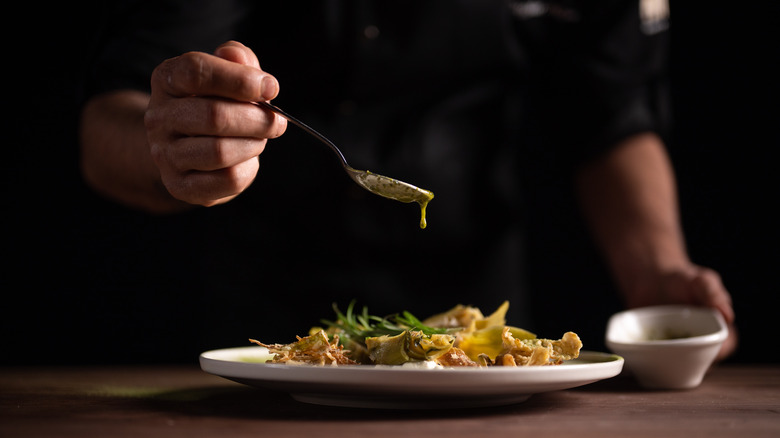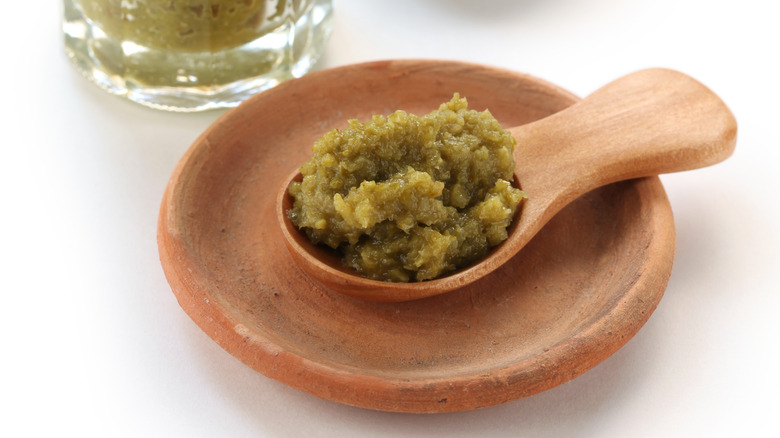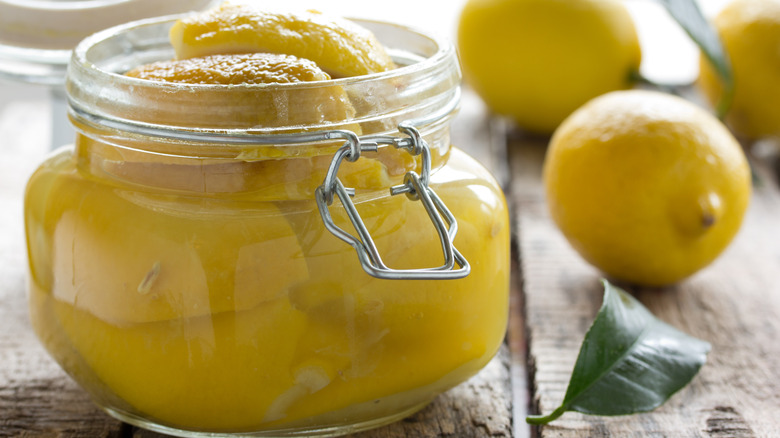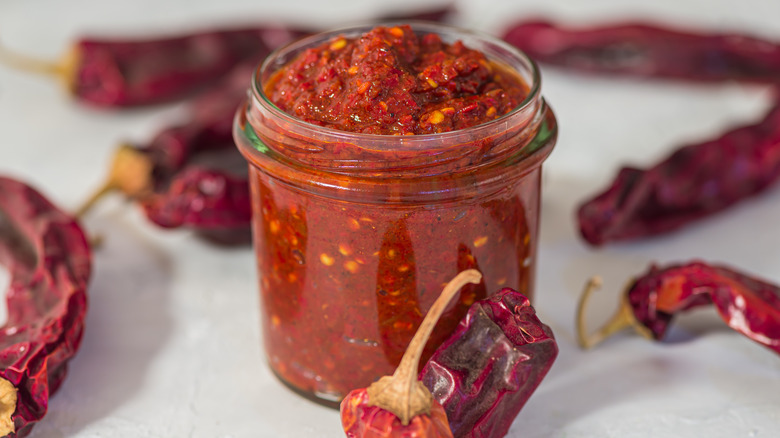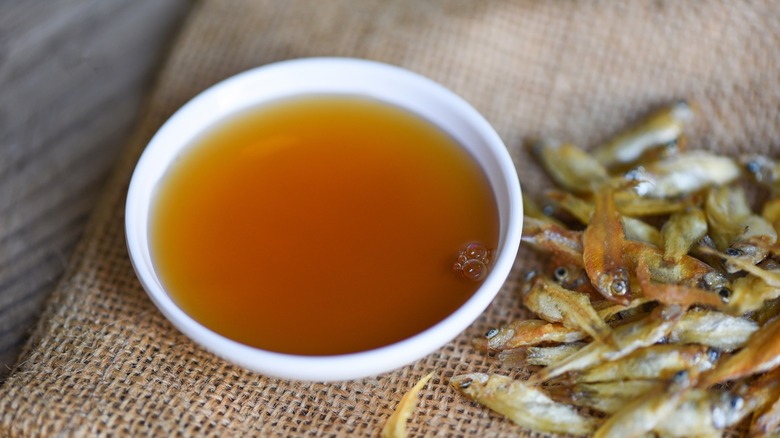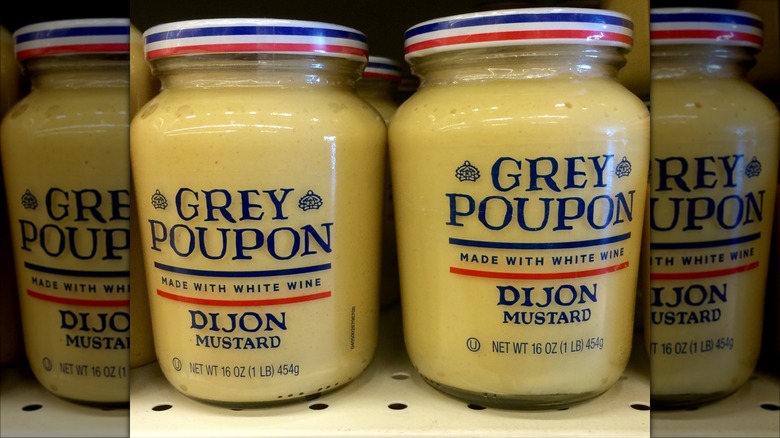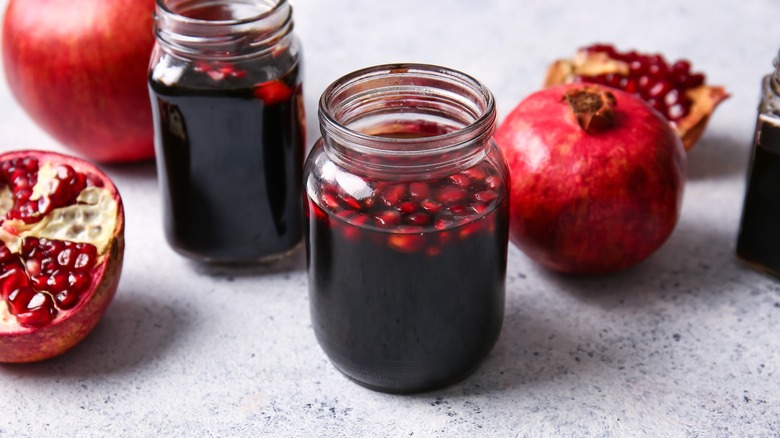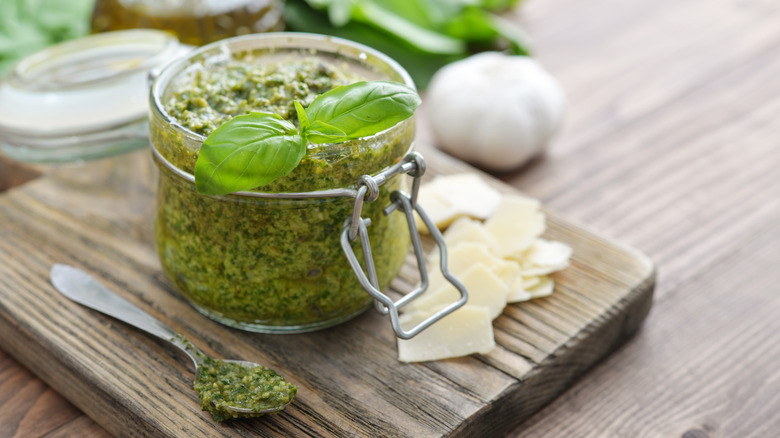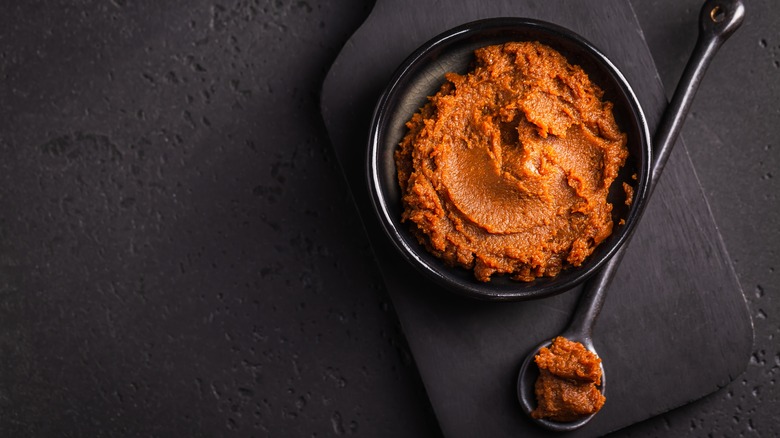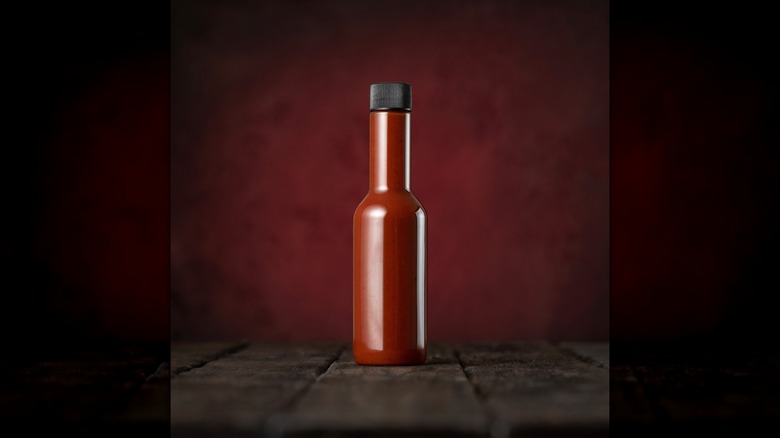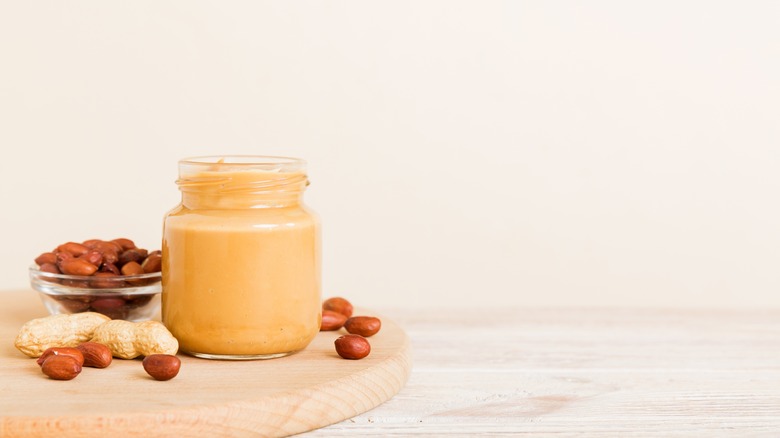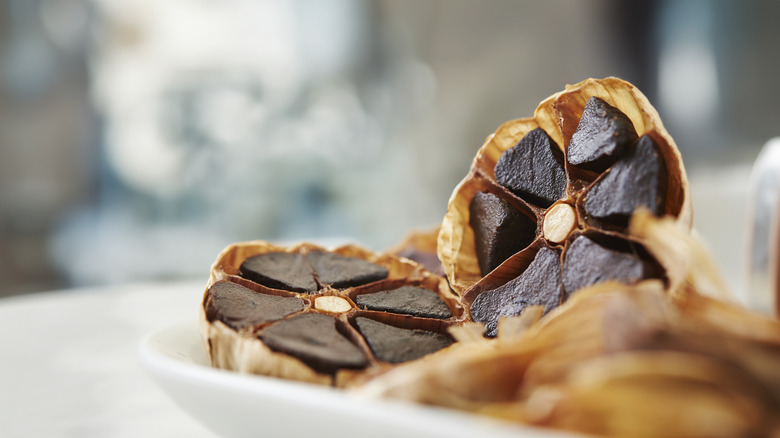Store-Bought Condiments That Will Transform Your Meals
Open your fridge or pantry and you're likely to find at least a couple of condiments. Ketchup, mustard, and mayo are the usual suspects, but you might even have something fancy like horseradish or chutney. Condiments cover a wide range of ingredients. Some, like salt and vinegar, are crucial to the flavor of a dish but are usually invisible. Others, like yellow mustard and pomegranate molasses, provide powerful flavors but also elevate the aesthetic appeal of a dish. In all cases, condiments are punching far above their weight. You might use as little as a pinch or a teaspoon of them in any given recipe, but they will still be integral to the result. This category of ingredients is crucial. Condiments balance flavors, provide color and textural variation, and even, in some cases, act as digestive aids.
While most of us have a handful of steadfast condiments taking up real estate in the kitchen, there are many products that remain less common despite being just as transformative. We'll explain more about our selection process at the end, but for now, we've rounded up 14 store-bought condiments that will level-up your cooking game no matter your level of culinary expertise.
Maple syrup
Forget about pancakes and waffles, maple syrup can enhance foods across the flavor spectrum. From martinis to carrots, it is an all-purpose condiment that adds a flavor all its own. Maple syrup is so common in North America that most of us don't think twice about where it comes from, but the process is quite involved, which explains why pure maple syrup is so pricey. The dark amber liquid is harvested by draining the sap of maple trees, usually in February and March. It is then heated to allow some of the moisture to evaporate, leaving the sugary, syrupy substance that we drizzle on our pancakes.
As anyone who's tried maple syrup can attest, its flavor is difficult to describe because there is no accurate substitute for it. It is sugary, caramelly, and, well, mapley, and it tastes just as delicious in oatmeal as it does in kale salad. For something savory, try our bacon-wrapped maple glazed carrot recipe, or opt for something even more unique with our eggnog martini recipe. Not sure which maple syrup to buy? We've created a handy guide of the best maple syrups to get you started.
Yuzu kosho
When it comes to Japanese condiments, shoyu (soy sauce) is probably the one most people know about. But if you're on the hunt for something with even more range, add a jar of yuzu kosho to your shelves. Made with fermented green chillies and yuzu, it offers savory notes, heat, and saltiness, a trio that complements a wide range of recipes.
Yuzu is a type of citrus fruit that looks like a small, bumpy lemon. With its powerfully aromatic, almost herbal flavor, it has become a favorite ingredient of bartenders and top-tier chefs. Yuzu kosho is the perfect ingredient to elevate pasta dishes, but its application doesn't stop there. Add it to soups to make the broth spicy, salty, and citrusy. Add it to meat dishes instead of using a marinade. You can even use it instead of hot sauce for a more complex flavor. Keep in mind that a little goes a long way, so start with a scant amount, taste, and then add more if needed.
Preserved lemons
Most cooks have experienced the magic that a simple squeeze of fresh lemon can provide a recipe, but until you've tried preserved lemons, you haven't fully enjoyed the potential of this humble citrus fruit. The ingredient Padma Lakshmi called "the unsung hero of Moroccan cuisine" is made by storing lemons in salt and allowing them to soften. The resulting texture is slightly mushy, like any other form of fruit preserves, with a salty, lemony flavor that is much more mellow than the pure acidity of fresh lemons.
Preserved lemons are an essential part of North African cuisine and are found in everything from chicken tagine to salad. Our recipe for Moroccan-inspired whole-roasted branzino is the perfect showcase for the sweet and tangy flavor of the ingredient, and you can even try it as a novel ingredient in your mixed drinks for a burst of summery flavor.
Although you can make your own preserved lemons, they take weeks to ferment. If you're looking for an easy alternative, just buy a jar instead. Unlike some other ingredients, the difference between store-bought versus homemade is negligible.
Harissa
There are many ways to add heat to a recipe, whether you're simply adding a few twists of a pepper grinder or piling in the jalapeños. If you want something that offers more than just spiciness, however, the North African staple harissa has it all. Made by combining red chilies, tomato paste, garlic, red pepper, lemon, olive oil, and a medley of spices (coriander, cumin, caraway seeds, smoked paprika, and cayenne pepper are popular), it is a vibrant, brick-red paste that provides heat, tanginess, and smokiness.
Unlike many other condiments, harissa is often the defining flavor in a recipe. If you're cooking with fish sauce or salt, you probably don't want them to be the overriding flavors of the dish, but harissa is such a delicious ingredient that it deserves to be the star of the show. Our recipe for harissa roasted cauliflower is a prime example of how transformative it can be. Cauliflower isn't the most exciting of ingredients, but all you need to do to make it your new favorite side dish is add a hint of harissa. This recipe contains only four ingredients — cauliflower, harissa, oil, and salt — and it will knock your socks off.
Fish sauce
Fish sauce can be a tough proposition to those who have never used it. Take even the tiniest whiff of this powerful ingredient and it might make your eyes water with its potency. The dark brown liquid is usually made with nothing more than salt and fermented anchovies, explaining why its overwhelming smell might be more of a deterrent than a selling point. But if you love Thai, Chinese, or Vietnamese food, you can probably thank fish sauce, and incorporating it into your cooking will unlock a whole new world of flavor.
Unlike many other condiments, fish sauce is not usually identifiable in a dish unless you have trained taste buds. When combined with other ingredients, its intense fishiness is miraculously transformed into a deep umami flavor. You won't catch even a hint of fish. From pad Thai to tom kha gai, fish sauce is the unsung cornerstone of many a South Asian dish. The key to using it successfully is moderation. For five servings of our recipe for make-at-home pad thai sauce, for example, you only need two tablespoons.
Dijon mustard
Dijon mustard might be known primarily as the more grown-up (and spicy) alternative to yellow mustard, but it can play a much more wide ranging role in your cooking than as a peripheral ingredient in sandwiches and salad dressing. As its name suggests, Dijon mustard has French origins. As Tasting Table notes, mustard itself dates back almost 5,000 years, but it was in Burgundy — the land of some of the world's finest wine — that the spicy, pale yellow Dijon mustard was first made. The Romans had been planting mustard seeds alongside grapevines for centuries due to the essential nutrients they provide, but it wasn't until the 1750s when monks began mashing the seeds with the sour juice of unripe grapes that Dijon mustard was born.
Dijon mustard is the perfect combination of spicy and sour. It won't make your eyes and nose water, but it will add a fiery kick to a recipe. It is also highly versatile in savory dishes. Our 20-minute sausage and potatoes dinner recipe capitalizes on its ability to elevate and deepen other seasonings like onions and herbs, while our easy ribeye roast recipe demonstrates what an excellent marinade it can make when you don't have time to whip up something more complicated.
Static Media owns and operates Tasting Table and Mashed.
Pomegranate molasses
Pomegranate molasses may not be ubiquitous in American households, but in many parts of the Middle East, it is an essential ingredient. Once you start cooking with it, you'll see why. Made by reducing pomegranate juice until it becomes a thick syrup, it is sweet and tangy with a deep red hue.
If you're looking for an all-purpose condiment to fall in love with, pomegranate molasses might just be it. Not only can you use it as a less sweet alternative to sugar or honey, but it can also act as a natural food dye and enhance many savory dishes. It's the secret ingredient Bobby Flay adds to salad dressing (try our pomegranate chicken salad recipe to see why he's such a fan), and Padma Lakshmi told Mashed in 2022 that she loves drizzling it on cheese. Once you have a bottle of pomegranate molasses in your pantry, you'll find yourself using it all the time, whether you're spooning it into sparkling water for a refreshing drink or drizzling it over oatmeal as a garnish.
Truffle oil
There are those who say that truffle peaked as a flavor somewhere back in the late 2010s, and while it's true that some culinary enthusiasts may have grown weary of the potent flavor cropping up in everything from popcorn to ice cream, all that hype wasn't just a fluke. Truffles have a unique flavor and aroma that, if it suits your preferences, is irresistable. Their taste is earthy, intense, full of umami, and even, according to some observers, reminiscent of gasoline. Truffles themselves are prohibitively expensive and hard to get your hands on, which is why truffle oil has become so popular. As Tasting Table explained, this condiment can be a bit of a misnomer. The purest form of the ingredient is olive oil infused with actual truffles, but the vast majority of products on the market are simply made with synthetic aromatic molecules that mimic the flavor of the pricey fungus but contain not a single trace of it.
This fact might deter some cooks from buying it and make professional chefs clutch their pearls, but if you're looking for a quick flourish to a meal, truffle oil has what it takes. Our recipe for air fryer truffle fries exemplifies this, producing decadent results that taste not only indulgent but gourmet.
Pesto
When the summer hits, having an ingredient in your fridge that tastes like sunshine in a bottle is one of the quickest ways to become the star of any barbecue. Pesto is just such an ingredient. The potent green condiment is made with basil, Parmesan, pine nuts, olive oil, and garlic and provides both color and flavor. You can mix it into hummus, make a mouthwatering summer pesto pasta salad, or make a delicious breakfast out of only three ingredients with our recipe for pesto eggs. Bursting with refreshing, lightly spicy flavor, it takes just one or two tablespoons to transform a dish.
One of the selling points of pesto is that it is so readily available. You'll find multiple versions of it at many grocery stores, and they will probably range quite a bit in price. For this reason, we created a list of 16 jarred pestos, ranked worst to best, and you'll be happy to know that price doesn't always correlate to quality.
Balsamic vinegar
Vinegar is a crucial ingredient in many foods, such as pickles and ketchup, but balsamic vinegar is in a whole other category. Traditionally, it's made by boiling, fermenting, and aging juice from white grapes for 12 to 25 years. That's right, it takes more than a decade to make traditional balsamic vinegar. Technological advances have sped up the process, but it still takes a minimum of about two months. The resulting liquid is worth the wait. Full of depth, it is rich, sweet, tangy, acidic, and full-bodied like a glass of fine red wine.
Incorporating it into your cooking is easy. Turn it into a marinade for this delicious sheet-pan balsamic chicken and vegetables recipe, or use it in place of regular vinegar in salad dressing. One of the best options is to reduce it into a syrupy consistency by heating it. With the resulting balsamic reduction, you can drizzle it over ice cream for a sweet and intensely tangy garnish or use it as a dipping sauce for our version of Giada's bruschetta. To make a sweet balsamic glaze, simply add a little honey.
Miso
Of the five basic tastes — salt, sweet, bitter, sour, and umami — umami might be the hardest to describe. It is that rich, earthy flavor that provides the foundation of many savory foods, including meat and soy sauce, but if you were asked to identify it beyond that, it would be tricky. For an ingredient that exemplifies umami, look no further than miso, the fermented soybean paste that is irreplaceable in Japanese cuisine. It has a rich, salty, buttery quality that can transform a recipe without drawing attention to itself. It makes meat taste meatier, soup taste rich and salty, and ramen noodles taste even more indulgent. In short, it's the kind of ingredient you want to have in your back pocket at all times, especially considering that it's actually pretty healthy.
If you're new to using miso, there is no shortage of places to start. Our healthy miso ginger salad demonstrates its ability to make even the most minimalist salad taste like a main dish, while our miso butter shrimp scampi shows how delicious it is when combined with shellfish. Last but not least is miso soup, one of the most comforting dishes for cold weather, illness, or pretty much any other occasion. Healthy, warming, and full of flavor, it gives chicken noodle soup a run for its money any day.
Barbecue sauce
Despite its name, barbecue sauce doesn't need a barbecue or even meat to belong on the menu. Known for its sweet and vinegary flavor, it usually contains tomato paste, brown sugar, vinegar, and spices like paprika and mustard. Some variations also have liquid smoke or smoke flavor to mimic the effect of grilling. There are many unexpected ways to use barbecue sauce that have nothing to do with outdoor cooking. Mix it into mayonnaise to upgrade your next sandwich, use it on pizza instead of marinara, or spoon it over eggs for a memorable breakfast. You can even mix it into chili, casseroles, and mac and cheese for added depth. It might not be detectable, but people will be asking you for the recipe.
As with most popular condiments, there are many barbecue sauces on the market that vary widely in quality. Make sure to read through our list of grocery store barbecue sauces, ranked worst to first, to make sure you aren't wasting your money or cooking time.
Peanut butter
Beyond chocolate and a PB & J, peanut butter is full of potential. Its singular nutty flavor and creamy texture isn't limited to sweet recipes (as long as you steer clear from sweetened versions of the product). It can make a standout salad dressing that is both creamy and full of flavor, while our recipe for stir-fried butter chicken will make you forget about PB & Js altogether. If you are a fan of sweet treats, there is, of course, no shortage of options either. Leave chocolate behind and try this three-ingredient peanut butter ice cream recipe, or forget about food entirely and whip up this peanut butter latte. Rich, sweet, and perfectly balanced, it is heaven in a mug.
Peanut butter is such a beloved ingredient that you might already have a tried-and-true brand that you'll never abandon, but if you're open to a change or aren't sure where to start, our list of 20 peanut butter brands, ranked worst to best, has all the information you need to pick a product that is fresh and full of flavor.
Chopped black garlic
Garlic is the kind of ingredient that would be tough to live without. Like salt and sugar, it balances the other ingredients in a dish, and in a similar way to onions and spices, it adds flavor. Whether you're making a quick omelet or are struggling to find enough ingredients in your fridge to revive a bland stir-fry, garlic is all you need to turn the conundrum into a success. Raw garlic, sautéed garlic, and roasted garlic are fairly common, but black garlic is less well-known. Made by curing raw garlic in a hot, humid environment for several weeks, it is mellow, soft, sweet, and, as its name suggests, black. It might sound like a bold ingredient, but it is actually a more mild version of the potent allium. You can make it at home, but given the time and precise curing specifications it requires, it's easier to buy it.
Black garlic is such a versatile and transformative ingredient that it was one of the products mentioned when we looked into the store-bought foods that chefs secretly love. According to Josh Feathers, the Executive Chef of the Main House at Blackberry Farm in Tennessee, it's worth having a jar of it around whenever you need to elevate a dish. Simply spoon it onto a chicken cutlet or filet of fish and it's ready to serve. You can also mix it into soups and sauces, spread it on sandwiches, or add it to dips.
Methodology
To create a list of store-bought condiments that will transform your meals, we combed through food blogs, chef interviews, and culinary websites to find products that are held in high esteem by expert chefs and home cooks alike. We focused on condiments that are not ubiquitous in most households — like salt and pepper — to ensure that each recommendation is informative.
We also focused on the culinary value of each product rather than their price tags or availability. As a result, the condiments we suggest here vary widely in cost and a few may only be available from specialty food stores or from online retailers.
